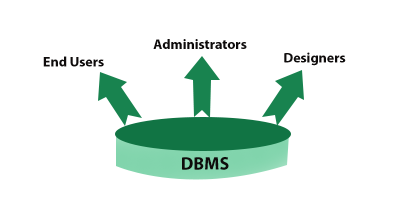Home >>DBMS Tutorial >DBMS Overview
DBMS Overview
DBMS Overview
A database is a collection of relevant data and a collection of facts and figures that can be processed for the production of data.
Data represents mainly recordable facts. Data helps to produce data that is based on facts. If we have information on marks received by all students, for example, we can then conclude about toppers and average marks.
In such a way that it becomes easier to retrieve, process, and produce information, a database management system stores data.
Characteristics
Data has traditionally been arranged in file formats. DBMS was then a new concept, and all the research was done to overcome the deficiencies of the conventional data management style. A modern DBMS has the following characteristics :-
- Real-world entity - A modern DBMS is more realistic and models the architecture using real-world entities. It also incorporates actions and attributes. A school database, for example, can use students as an individual and their age as an attribute.
- Relation based tables - DBMS enables tables to be created by entities and relations between them. Just by looking at the table names, a user can understand the architecture of a database.
- Data and application isolation - A database system is entirely different from its data. A database is an active entity, while the data that the database manages and arranges is said to be passive. In order to ease their own process, DBMS often stores metadata, which is data information.
- Less redundancy - DBMS follows the rules of normalisation that splits a partnership when all of its attributes have redundancy in values. Normalization is a method that is mathematically rich and scientific, reducing data redundancy.
- Consistency - Consistency is a state in which any relation remains consistent in a database. Methods and methods exist that can detect attempts to leave the database in an inconsistent state. Compared to the previous types of data energy storage, such as file-processing systems, a DBMS may provide greater consistency.
- Query Language - DBMS is equipped with a query language , making data retrieval and processing more efficient. A user can use as many filtering options as possible to retrieve a collection of data. Traditionally, where file-processing systems were used, it was not possible.
- ACID Properties - DBMS follows the atomicity, consistency, isolation, and durability (normally shortened as ACID) principles of ACID Properties. These principles apply to transactions that, in a database, manipulate data. In multi-transactional environments and in the event of failure, ACID properties help the database stay healthy.
- Multiuser and Concurrent Access − DBMS supports multi-user applications and allows them to view and control data in parallel. Multi-user and Concurrent View While transaction restrictions occur when users try and deal with the same data item, users are still unaware of them.
- Multiple views - DBMS provides multiple views for various users. A user in the Department of Sales would have a different view of the database than a person in the Department of Production. This role allows users to have a focused view of the database according to their requirements.
- Security -Features such as multiple views provide security to the extent that other users and departments can not access data from users. DBMS provides methods to enforce constraints when entering and retrieving data into the database at a later level. DBMS provides several different levels of security features , allowing multiple users with different applications to have different views. In the Sales Department , for example, an user does not see the data that belongs to the Purchasing Department. In addition, how much data should be shown to the user by the Sales Department can also be handled. Since a DBMS is not saved like a traditional file system on the file, it is very difficult to break the code for miscreants.
Users
A typical DBMS has users who use it for various purposes with different rights and permissions. Many users retrieve information and others back it up. The users of a DBMS can be characterized broadly as follows :-

- Administrators - Administrators manage the DBMS and are responsible for the database administration. We are responsible for the care of its use and by whom it should be used. They build users' access profiles and apply limitations to preserve isolation and security of force. DBMS resources such as system licences, required tools, and other maintenance related to software and hardware are also looked after by administrators.
- Designers - Designers are the group of individuals who generally work on the database aspect of the design. On what details should be kept and in what format, they keep a close eye. The entire set of entities, relations, constraints, and views are defined and designed.
- End Users - End users are those who are currently benefiting from using a DBMS. End users may vary from basic viewers to advanced users such as business analysts who pay attention to the logs or market rates.
